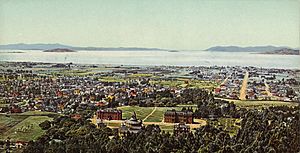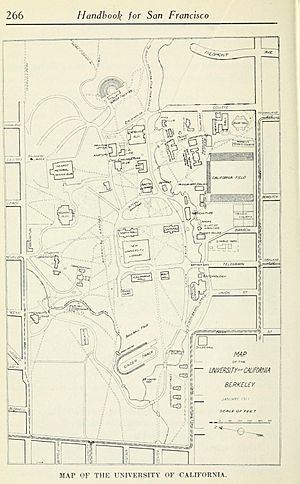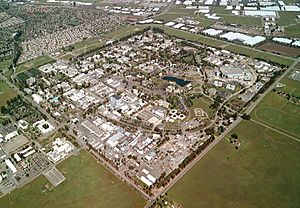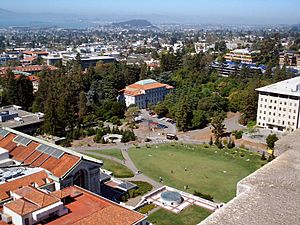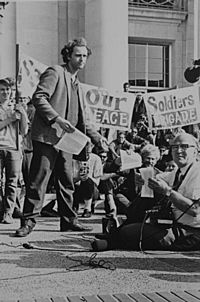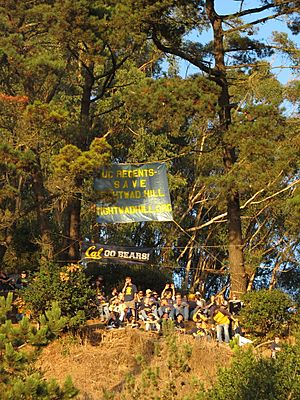History of the University of California, Berkeley facts for kids
The University of California, Berkeley started its journey on October 13, 1849. That's when California's first constitution was created, which planned for a public university. On March 23, 1868, a special law called the Organic Act officially created the University of California. This new university took over the land and buildings from a private school called the College of California. It also became eligible for money from the government, like other public colleges focused on farming, mining, and mechanical arts.
Contents
The 1800s: How Berkeley Began
Starting the University
In 1866, the College of California, a private school in Oakland, bought the land where the Berkeley campus is today. Around the same time, the State of California set up a college for agriculture, mining, and mechanical arts. This state college was mainly created to get money from a federal law called the Morrill Act. This act, signed by Abraham Lincoln in 1862, helped fund public universities by giving them land.
In 1867, the College of California was having money troubles. With help from Governor Frederick Low, they agreed to join with the state college. Then, on March 23, 1868, Governor Henry H. Haight signed the Organic Act. This law officially created the University of California as the state's first "land-grant" university. While many think it was a simple merger, the Organic Act actually created a "completely new institution."
The Organic Act, also known as the Dwinelle Bill, said the university's goal was to offer "thorough and complete education in all departments of science, literature and art, industrial and professional pursuits."
Professor John LeConte was the first temporary president. In 1870, Henry Durant was elected president. The university opened in September 1869. It used the old College of California buildings in Oakland while its new campus was being built.
Early Growth and Changes
In 1871, the university decided that women should be allowed to attend classes just like men.
On November 7, 1872, Daniel Coit Gilman became the second president. He said the university should be unique to California, serving "of the people and for the people" in the best way possible.
In 1873, the university moved to its new Berkeley location. The first main buildings, North and South Halls, were finished. There were 167 male students and 22 female students.
In 1874, Rosa L. Scrivner became the first woman to graduate from the University of California. She earned a degree in Agriculture. In 1876, Elizabeth Bragg became the first woman in America to get a degree in Civil Engineering, right here at Berkeley.
Many people helped the university grow. In 1881, Henry Douglas Bacon gave books and art, and paid for Bacon Hall, a library and art museum.
The university's first research center was an observatory on Mount Hamilton. It started in 1888, paid for by a gift from California landowner James Lick.
Starting in 1891, Phoebe Apperson Hearst gave many large gifts to Berkeley. She supported programs, helped with architectural contests, and funded buildings like Hearst Memorial Mining Building. Levi Strauss, known for his jeans, gave money for 28 scholarships in 1897. In 1898, Cora Jane Flood donated land and water rights. This gift helped start Berkeley's business school, now called the Haas School. It was the first business school at a public university in the country.
The 1900s: Becoming a Major University
The university really grew under President Benjamin Ide Wheeler, who led from 1899 to 1919. He brought famous professors to campus and found money for research.
In 1905, a "University Farm" was created near Sacramento. This farm later became the University of California, Davis.
Many beautiful buildings were completed, giving the campus a grand university look. These included California Memorial Stadium (1923) and other buildings designed by architect John Galen Howard. These buildings are still central to Berkeley's campus today.
In the 1910s, Berkeley students played a part in the Indian Independence Movement. Indian students at the university formed the Ghadar Party and published a newspaper, the Hindustan Ghadar.
In 1928, John D. Rockefeller Jr. funded the International House Berkeley. It opened on August 18, 1930. This was a special place for international students, the first co-ed student housing west of the Mississippi River.
Robert Gordon Sproul became president in 1930 and served for 28 years. During his time, Berkeley became known worldwide as a top research university. Even with money cuts during the Great Depression and World War II, Sproul kept academic standards high by raising private funds. By 1942, Berkeley was ranked second only to Harvard University for its excellent departments.
Because of the Morrill Act, male students were required to get military training. This included drills and marksmanship. In 1904, the requirement was shortened. In 1917, Berkeley's ROTC (Reserve Officers' Training Corps) unit was created. Commander Chester W. Nimitz started the Naval ROTC at Berkeley in 1926. Berkeley has trained many military leaders.
World War II and Atomic Research
During World War II, Ernest Orlando Lawrence's Radiation Laboratory near Berkeley worked with the U.S. Army. They helped develop the atomic bomb. This involved Berkeley's advanced research in nuclear physics. Glenn T. Seaborg secretly discovered plutonium in Room 307 of Gilman Hall, which is now a historic landmark. Berkeley physics professor J. Robert Oppenheimer became the scientific head of the Manhattan Project in 1942. The University of California also helped manage other important labs like Los Alamos National Laboratory and Lawrence Livermore National Laboratory.
From 1943 to 1946, Berkeley was part of the V-12 Navy College Training Program. The military used campus buildings to train officers. By 1944, over 1,000 navy personnel were studying at Berkeley. After the war, students pushed for change, and compulsory military training ended at Berkeley in 1962.
The 1950s: A New System
In 1949, the university's leaders, the Board of Regents, required all employees to sign an anti-communist loyalty oath. Some professors refused and were fired, but they were later given their jobs back. Today, employees who are U.S. citizens still take an oath to support the U.S. and California Constitutions.
Before 1952, Berkeley was simply "the University of California." Other locations were seen as smaller parts of it. But in 1951, the University of California started to become a system of many campuses. Each campus would have its own leader, a chancellor. In 1952, Clark Kerr became Berkeley's first Chancellor. When Kerr became president of the whole system in 1957, Berkeley officially became the "University of California, Berkeley." People often shorten its name to "Berkeley" or "Cal," especially for sports teams.
In 1958, professors suggested creating a lab for rocket and satellite technology. The Space Sciences Laboratory was formed in 1959. It has made important contributions to many NASA programs.
The 1960s: A Time of Change
In the 1960s, Berkeley became famous worldwide for student activism. This began with the Free Speech Movement. Sproul Plaza, near the university's main entrance, was a popular spot for speeches. In 1964, the university banned political activity on campus. On October 1, 1964, Jack Weinberg was arrested for having a political booth in Sproul Plaza. This led to student protests and civil disobedience, starting the Free Speech Movement. The students eventually won, and this movement set a precedent for later protests, like those against the Vietnam War.
A very well-known event during this time was the 1969 protest over People's Park. This was a conflict between the university and students/residents over a piece of land. Students and locals turned it into a community park. But the university wanted the land back for athletic fields. When law enforcement cleared the park, it caused a large protest. California Governor Ronald Reagan called in the National Guard. The violence that followed led to injuries and the death of one student. People's Park is still used as a community park today.
Berkeley Today
Today, Berkeley students are still known for being active, though perhaps less politically focused than in the 1960s. In a 2005 poll, most Berkeley freshmen considered themselves liberal or moderate. The Berkeley College Republicans is the largest political group on campus for students who lean conservative.
While Berkeley is often seen as a liberal place, some groups have protested research done there. Native American groups have concerns about how the university handles the return of cultural items. Animal-rights activists have protested research involving animals. Also, the university's plans to build a new athletic center have faced opposition from local community members and alumni.
As of 2006, Berkeley needed a lot of money to keep its buildings and facilities in good shape. Because it's already full of students, it often gets less state money for improvements than other growing campuses. So, Berkeley increasingly relies on private donations for research. For example, in 2007, BP gave $500 million for a research lab to develop biofuels. The Hewlett Foundation gave $113 million for faculty positions, and Dow Chemical gave $10 million for a research program on sustainability.
In 2010, UC Berkeley was recognized for having the most top-ranked doctoral programs in the nation. Many of its programs, like Astrophysics, Chemistry, Computer Science, and Physics, were ranked #1. Berkeley also received the most National Science Foundation Graduate Research Fellowships between 2001 and 2010.
The BP Deal
The $500 million, ten-year agreement between Berkeley, the Lawrence Berkeley Laboratory, the University of Illinois at Urbana–Champaign, and BP started on November 14, 2007. This was the largest grant in the university's history.
Some students and professors criticized the deal. They felt it was negotiated secretly and might harm Berkeley's reputation as an independent university. However, supporters argued that the money would help the campus, especially when public universities faced funding cuts. They also pointed out that the deal focused on developing alternative energy, which is important for the world.
Berkeley faculty and students work with BP scientists to design genetically modified plants and microbes for the bio-fuel industry. Some professors, like Ignacio Chapela, worried that this project might lead to farmland being used for fuel crops instead of food in poorer countries. Others, like Randy Schekman, supported the deal.
In March 2007, the UC Regents approved building a new research facility for the Energy Biosciences Institute (EBI), BP's name for the project. University officials called it "the first public-private institution of this scale in the world."
What's in a Name?
When it was founded, Berkeley was the first full public university in California. So, it was simply called the University of California. Like other states with one main public university, it was often shortened to California or Cal. Because its sports teams have a long history, they are still called California Golden Bears, Cal Bears, or just Cal. The name Berkeley was suggested by Andrew Gabrielson, a trustee, in honor of the philosopher George Berkeley.
As the University of California grew into a system with many campuses, the term University of California now refers to the entire system. The official name for the Berkeley campus is University of California, Berkeley. Informally, it's called UC Berkeley, Berkeley, or Cal.
Here's how the campus uses these names:
- "UC Berkeley" is used for talking to the general public.
- "Berkeley" is used in academic settings, like by colleges and departments.
- "Cal" is a friendly nickname, used by Cal Athletics, the alumni association, and student groups.
The university's trademark office discourages using "Cal Berkeley." While "UCB" is also registered, it's not actively used. The main website is berkeley.edu.


